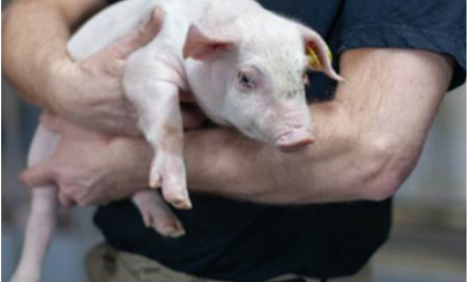



Energy-Efficient Fans for Swine Production
Advice on comparing and choosing the right fans for pig houses from Professor Jay Harmon, Dr Mark Hanna and Dr Dana Petersen of Iowa State University Extension.Fans are an important component of mechanically ventilated facilities. They are the driving force behind the exchange of air that is necessary to create a healthy environment for animals and associated farm employees. Other components of the ventilation system, such as the inlets and controllers, are essential to create a properly functioning system that is also energy-efficient.
Fans impact energy usage in two different ways. They not only use energy to operate but the management of fans greatly impacts the efficiency of the heating energy used within the building. Fan management is crucial in winter because over-ventilating exhausts heating energy needlessly. Swine housing systems often use variable speed fans which generally use the same amount of energy at a reduced speed as they do at full speed.
Quantifying Quality
To understand the principles of fan selection, it’s important to understand the following terms:
Air delivery: Air delivery is the amount of air that a fan will move under different conditions. This term is expressed as volume of air movement per unit time. The standard unit is cubic feet per minute (cfm).
Static pressure: Static pressure is the difference in pressure that a ventilation fan creates between the inside and outside of a mechanically ventilated structure. Static pressure may be measured using a manometer (Figure 1). Fans are used to create a vacuum within a building by exhausting air. The indoor environment, having a lower pressure than outdoors, will draw air in through inlets (Figure 2). This is called a negative pressure system. In most animal housing situations, the static pressure operates between 0.04 and 0.08 inches of water. A free hanging fan, such as a stirring fan, will operate with no static pressure.


Fan efficiency: Fan efficiency is the amount of air delivery that a fan will provide per unit of electricity used, given in cubic feet per minute per watt (cfm/W). In general, small fans are less efficient than larger fans. Efficiencies range from about 5 cfm/W to 25 cfm/W.
Fan Rating
Fans should be rated by an independent lab to show air delivery and efficiency as a function of static pressure. This information will be presented by using either a graph or table. An example appears in Table 1. Accessories on the fan such as guards, shutters and discharge cones impact performance and should be noted when examining test data. Test results are available from the Bioenvironmental and Structural Systems (BESS) lab at the University of Illinois.
| Table 1. Example fan data for a 24-inch fan with shutter, guard and discharge cone (BESS Lab) | |||
| Static pressure Inches of water |
Speed Rpm |
Airflow cfm |
Efficiency cfm/W |
|---|---|---|---|
| 0.00 | 1101 | 6490 | 16.1 |
| 0.05 | 1094 | 6090 | 14.7 |
| 0.10 | 1089 | 5740 | 13.4 |
| 0.15 | 1083 | 5250 | 12.2 |
| 0.20 | 1082 | 4760 | 10.8 |
| 0.25 | 1082 | 3950 | 9.0 |
| 0.30 | 1088 | 2330 | 5.6 |
A common mistake is to select fans based on fan diameter. Never assume that two fans of equal size will perform the same since different motors, curvature of blades and other attributes greatly influence the performance. For instance, it has been found through testing of several 24-inch fans that the air delivery (at 0.10 inches of water) ranged from 4,090 to 7,270 cfm, and the efficiency ranged from 9.9 to 17.1 cfm/W.
Selection Criteria
Mechanical ventilation systems are generally composed of multiple fans which are staged on as temperature rises. In most systems this begins with small fans, and larger fans are added to increase the air delivery. Fans should be selected based on air delivery and efficiency ratings at 0.10 inches of water. The shaded area of Table 1 illustrates the data that should be used for fan comparisons and selection. Efficiency is another criterion that should be considered. Table 2 shows median and upper quartile test results for efficiency ratings by fan size. Choose fans which are within the upper quartile of rated fan efficiencies. Many utility companies provide rebates for efficient fans that meet target efficiency.
Check with your electrical supplier for rebate requirements before purchasing fans.
| Table 2. Fan test results for efficiency based on fan size and 0.10 inches of H2O (BESS lab) | ||
| Diameter of fan | Efficiency rating | |
|---|---|---|
| Inches | Median rating cfm/W |
Top ¼ rating cfm/W |
| <16 | 7.9 | 8.7 |
| 16 to 20 | 10.3 | 11.2 |
| 22 to 35 | 13.0 | 14.6 |
| 36 to 46 | 15.9 | 17.2 |
| 48 to 56 | 18.9 | 20.4 |
| >56 | 20.1 | 21.5 |
Factors Affecting Fan Performance
The configuration in which a fan is installed and the manner in which it is maintained greatly affect its performance. Guards generally decrease the fan performance less than five per cent, and should always be left in place because they protect workers from the fan and the fan from objects. Shutters reduce fan performance 10 to 25 per cent but are necessary for periods when the fan is not operating. Dirty shutters and blades can reduce air delivery by as much as 40 per cent. Regular cleaning and maintenance will keep shutters operating at their manufactured level of efficiency. Well maintained discharge cones increase fan efficiency by 15 per cent or more. If belt-driven fans are used, check belt tension regularly. Loose belts will cause the fan to be less efficient and effective, perhaps by as much as 50 per cent. An over-tight belt will cause undue wear on bearings. Fan ratings are based on a fan that is in a new condition and should include all accessories which will be used in your application.
| Improper fan maintenance can negate energy savings from proper fan selection. Simple routine maintenance steps include: |
|
Summary
Good quality fans are essential for proper performance of mechanically ventilated swine facilities. Inefficient fans can add to production cost in two ways. The most obvious cost is wasted energy that is expended while using an inefficient fan. Other costs can be due to poor air quality in the building due to under-ventilation or wasted heat due to over-ventilation. Fans that are inefficient or mismanaged may allow air quality to diminish and therefore stress animals. Stressed animals are more susceptible to disease and also have less-than-optimal animal growth and feed conversion. Management and proper staging of fans is also an important part of an energy efficient system and will be dealt with in other fact sheets.
March 2010








